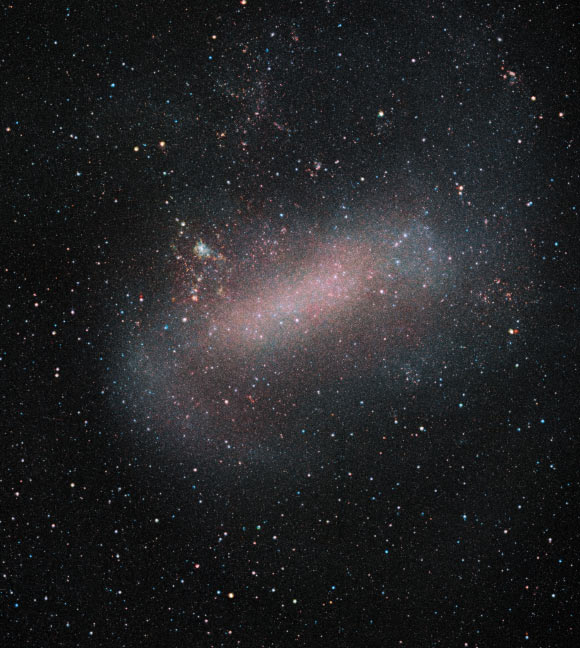Astronomers Chart 3D Structure of Magellanic Clouds
Sep 13, 2019 by Enrico de Lazaro
Using data from the VISTA Magellanic Clouds (VMC) Survey, astronomers have explored the morphology of the Large and Small Magellanic Clouds, which are among the nearest dwarf satellite galaxies to the Milky Way.

This remarkable image from ESO’s VISTA telescope shows the Large Magellanic Cloud, one of our nearest galactic neighbors. Image credit: ESO / VMC Survey.
The Large and Small Magellanic Clouds represent the nearest interacting pair of dwarf irregular galaxies.
They are 163,000 and 200,000 light-years from us, respectively, and 75,000 light-years from each other.
The Large Magellanic Cloud is an almost face-on, gas-rich galaxy characterized by an inclined disk and an offset bar of which the origin is not well understood.
The Small Magellanic Cloud is an elongated galaxy known for its less pronounced bar and its eastern extension.
These galaxies are the home of various stellar populations and are an ideal laboratory for astronomers to study the processes that shape galaxies.
“The main goal of the VMC Survey was to map the star formation history of the Large and Small Magellanic Clouds, as well as their 3D structures,” explained Dr. Dalal El Youssoufi from the Leibniz-Institut für Astrophysik and colleagues.
“ESO’s VISTA telescope observes the sky in near-infrared wavelengths of light. This allows it to see through clouds of dust that obscure parts of the galaxies.”
“These clouds block a large portion of visible light but are transparent at the longer wavelengths VISTA was built to observe.”
“As a result, many more of the individual stars populating the center of the galaxies are clearly visible.”

This VISTA image of the Small Magellanic Cloud shows millions of stars. Image credit: ESO / VISTA / VMC.
The astronomers analyzed 10 million individual stars in the Large Magellanic Cloud and 2.5 million stars in the Small Magellanic Cloud, and determined their ages using cutting-edge stellar models.
They found that main sequence stars trace multiple spiral arms in the Large Magellanic Cloud.
“Star forming regions become dimmer as we progress in age, while supergiant stars are centrally concentrated,” they said.
“Intermediate-age stars, despite tracing a regular and symmetrical morphology, show central clumps and hints of spiral arms.”
In the Small Magellanic Cloud, young stars depict a broken bar.
“Intermediate-age populations show signatures of elongation towards the Magellanic Bridge that can be attributed to the interaction of these galaxies 200 million years ago,” the researchers said.
“They also show irregular central features suggesting that the inner Small Magellanic Cloud has also been influenced by tidal interactions.”
The findings were published in the Monthly Notices of the Royal Astronomical Society.
_____
Dalal El Youssoufi et al. The VMC Survey – XXXIV. Morphology of Stellar Populations in the Magellanic Clouds. MNRAS, published online September 3, 2019; doi: 10.1093/mnras/stz2400
Thanks to: http://www.sci-news.com
Sep 13, 2019 by Enrico de Lazaro
Using data from the VISTA Magellanic Clouds (VMC) Survey, astronomers have explored the morphology of the Large and Small Magellanic Clouds, which are among the nearest dwarf satellite galaxies to the Milky Way.

This remarkable image from ESO’s VISTA telescope shows the Large Magellanic Cloud, one of our nearest galactic neighbors. Image credit: ESO / VMC Survey.
The Large and Small Magellanic Clouds represent the nearest interacting pair of dwarf irregular galaxies.
They are 163,000 and 200,000 light-years from us, respectively, and 75,000 light-years from each other.
The Large Magellanic Cloud is an almost face-on, gas-rich galaxy characterized by an inclined disk and an offset bar of which the origin is not well understood.
The Small Magellanic Cloud is an elongated galaxy known for its less pronounced bar and its eastern extension.
These galaxies are the home of various stellar populations and are an ideal laboratory for astronomers to study the processes that shape galaxies.
“The main goal of the VMC Survey was to map the star formation history of the Large and Small Magellanic Clouds, as well as their 3D structures,” explained Dr. Dalal El Youssoufi from the Leibniz-Institut für Astrophysik and colleagues.
“ESO’s VISTA telescope observes the sky in near-infrared wavelengths of light. This allows it to see through clouds of dust that obscure parts of the galaxies.”
“These clouds block a large portion of visible light but are transparent at the longer wavelengths VISTA was built to observe.”
“As a result, many more of the individual stars populating the center of the galaxies are clearly visible.”

This VISTA image of the Small Magellanic Cloud shows millions of stars. Image credit: ESO / VISTA / VMC.
The astronomers analyzed 10 million individual stars in the Large Magellanic Cloud and 2.5 million stars in the Small Magellanic Cloud, and determined their ages using cutting-edge stellar models.
They found that main sequence stars trace multiple spiral arms in the Large Magellanic Cloud.
“Star forming regions become dimmer as we progress in age, while supergiant stars are centrally concentrated,” they said.
“Intermediate-age stars, despite tracing a regular and symmetrical morphology, show central clumps and hints of spiral arms.”
In the Small Magellanic Cloud, young stars depict a broken bar.
“Intermediate-age populations show signatures of elongation towards the Magellanic Bridge that can be attributed to the interaction of these galaxies 200 million years ago,” the researchers said.
“They also show irregular central features suggesting that the inner Small Magellanic Cloud has also been influenced by tidal interactions.”
The findings were published in the Monthly Notices of the Royal Astronomical Society.
_____
Dalal El Youssoufi et al. The VMC Survey – XXXIV. Morphology of Stellar Populations in the Magellanic Clouds. MNRAS, published online September 3, 2019; doi: 10.1093/mnras/stz2400
Thanks to: http://www.sci-news.com






 Sat Mar 23, 2024 11:33 pm by globalturbo
Sat Mar 23, 2024 11:33 pm by globalturbo

